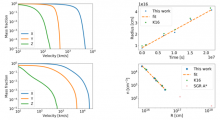
Abstract
When a star gets too close to a supermassive black hole, it is torn apart by the tidal forces. Roughly half of the stellar mass becomes unbound and flies away at tremendous velocities - around 104 km/s. In this work we explore the idea that the shock produced by the interaction of the unbound debris with the ambient medium gives rise to the synchrotron radio emission observed in several TDEs. We use a moving mesh numerical simulation to study the evolution of the unbound debris and the bow shock around it. We find that as the periapse distance of the star decreases, the outflow becomes faster and wider. A tidal disruption event whose periapse distance is a factor of 7 smaller than the tidal radius can account for the radio emission observed in ASASSN-14li. This model also allows us to obtain a more accurate estimate for the gas density around the centre of the host galaxy of ASASSN-14li.